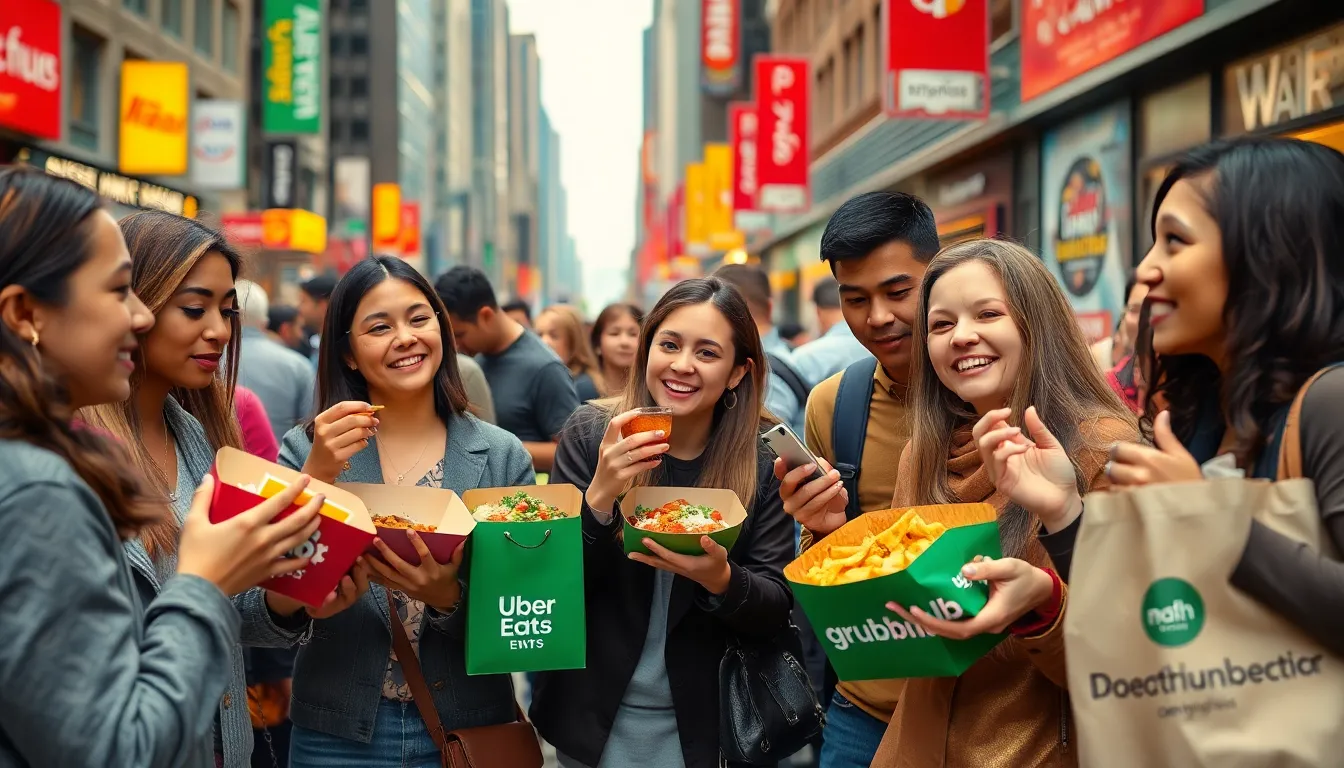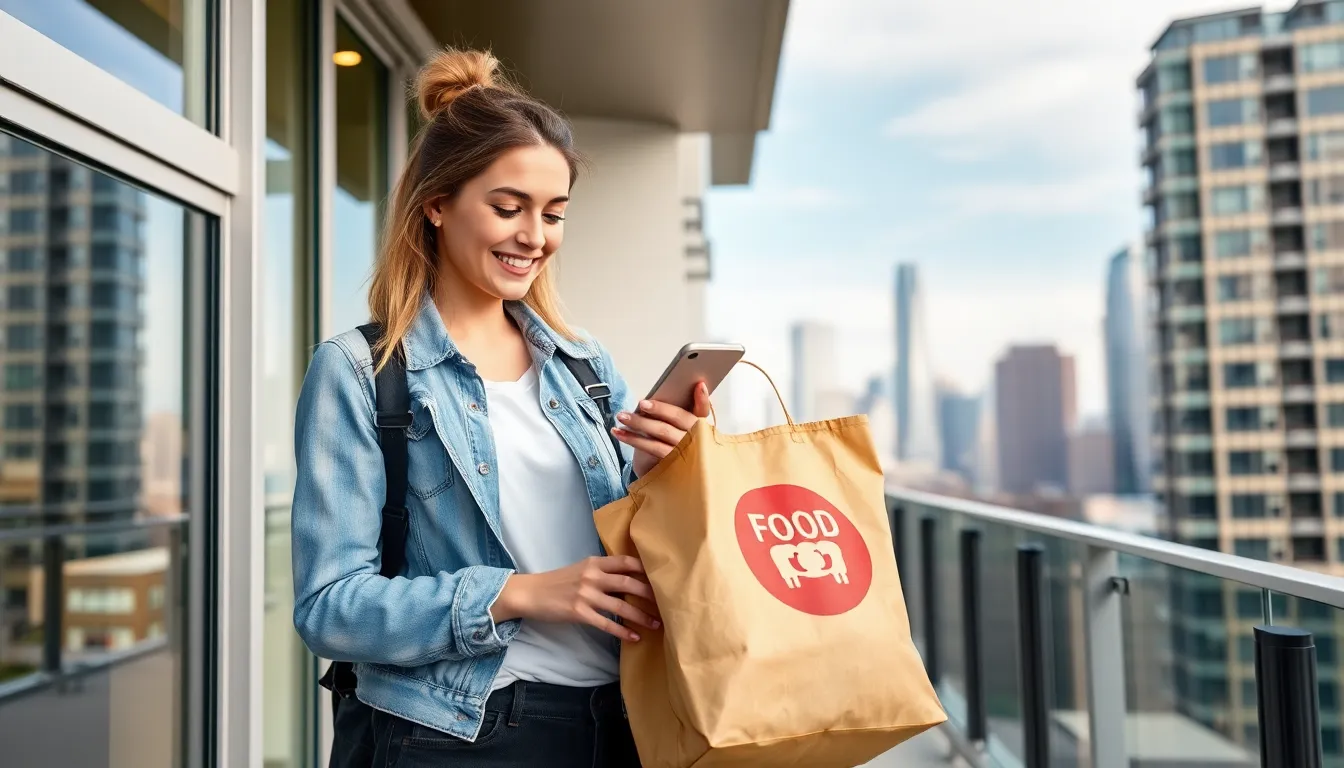In today’s fast-paced world, food delivery apps have transformed the way people enjoy their meals. With just a few taps on a smartphone, users can explore a vast array of cuisines and have their favorite dishes delivered right to their doorstep. This convenience has made these apps a staple for busy professionals, families, and anyone craving a delicious meal without the hassle of cooking.
As technology continues to evolve, the food delivery industry is experiencing rapid growth. From local favorites to international chains, these platforms cater to diverse tastes and preferences. With options for every budget and dietary need, food delivery apps are not just changing how people eat; they’re redefining the dining experience itself.
Table of Contents
ToggleOverview of Food Delivery Apps
Food delivery apps serve as essential platforms that connect consumers with local restaurants and eateries. These applications streamline the ordering process by allowing users to browse menus, customize orders, and track deliveries in real time. The ease of access enables convenience for users, who often lead busy lifestyles.
The range of food delivery apps has expanded significantly, featuring many services such as Uber Eats, Grubhub, and DoorDash. These platforms cater to diverse dietary preferences, including vegetarian, vegan, and gluten-free options. Users benefit from extensive database selections that encompass various cuisines, making it simple to explore new flavors.
Food delivery apps leverage technology to ensure efficient operations. GPS tracking systems allow users to monitor their delivery status, while integrated payment options provide secure transactions. Many applications offer promotional deals and discounts, incentivizing users to order frequently.
Consumer behavior reflects a growing reliance on food delivery services. Statistics indicate that as of 2022, the food delivery industry reached approximately $150 billion in revenue. This trend suggests that food delivery apps will play a critical role in shaping the future of dining experiences.
Popular Food Delivery Apps

Food delivery apps gained popularity due to their convenience and diverse culinary options. Several major players dominate the market, each offering unique features that cater to various consumer preferences.
Features Comparison
- Uber Eats: Offers extensive restaurant choices, real-time order tracking, and user-friendly interface. It supports contactless delivery options for safety.
- Grubhub: Provides a large selection of local eateries, loyalty rewards for frequent users, and allows pre-ordering for scheduled deliveries.
- DoorDash: Features a subscription service called DashPass, which includes reduced delivery fees and access to exclusive deals. It also allows users to schedule deliveries in advance.
- Postmates: Delivers food along with groceries and convenience items. It emphasizes flexibility with delivery from various local retailers, not limited to restaurants.
- Caviar: Focuses on high-end dining, offering premium experiences with curated restaurant selections and white-glove delivery service.
Pricing and Delivery Options
| App | Delivery Fee | Minimum Order | Subscription Service |
|---|---|---|---|
| Uber Eats | Varies, usually $1.99 to $5.99 | $0 | Uber Eats Pass |
| Grubhub | Varies, usually $1.50 to $10 | $10 | Grubhub+ |
| DoorDash | $0 to $8, often waived for DashPass | $0 | DashPass |
| Postmates | Around $2 to $7 | No minimum | Postmates Unlimited |
| Caviar | Generally 10% of total | $15 | No subscription service |
Food delivery apps offer flexible pricing and various delivery options that cater to an array of budgets and preferences. Apps regularly run promotional deals, enhancing the affordability factor for users and encouraging usage.
Impact of Food Delivery Apps on Restaurants
Food delivery apps significantly influence restaurant operations, reshaping both benefits and challenges faced within the industry. As these platforms continue to proliferate, understanding their impact becomes essential for restaurant owners and operators.
Benefits for Restaurant Owners
- Increased Reach: Food delivery apps expand a restaurant’s market footprint, allowing businesses to attract customers beyond their physical location. This increased exposure leads to higher order volumes and revenue potential.
- Cost Efficiency: Many restaurants leverage food delivery apps to reduce overhead costs related to in-house delivery operations. Outsourcing delivery mitigates the need for dedicated staff and vehicles.
- Streamlined Operations: Integration with ordering systems simplifies the workflow for restaurant staff. Enhanced order management leads to improved accuracy and efficiency during peak hours.
- Marketing Opportunities: Partnering with food delivery apps provides restaurants access to promotional features and advertisements, assisting in brand visibility and consumer engagement.
- Consumer Insights: Food delivery platforms often furnish data analytics, informing restaurants about customer preferences and dining trends, aiding in menu optimization and targeted marketing efforts.
Challenges Faced by Restaurants
- Commission Fees: Many food delivery apps charge substantial commission fees, which can decimate profit margins for restaurants, particularly smaller establishments.
- Loss of Customer Relationships: Utilizing third-party platforms may hinder direct communication between restaurants and customers, reducing opportunities for building loyalty.
- Quality Control Issues: Maintaining food quality during transit presents challenges. Delayed deliveries or mishandling can negatively impact a restaurant’s reputation.
- Menu Limitations: Some food delivery apps impose restrictions on menu items, making it difficult for restaurants to showcase their full culinary range.
- Increased Competition: Restaurants must navigate a crowded online marketplace, where numerous dining options compete for consumer attention, leading to price wars and elevated marketing expenses.
User Experience with Food Delivery Apps
Food delivery apps prioritize user experience through intuitive design and streamlined functionality. Convenience and satisfaction drive customer engagement and retention in this competitive market.
Ease of Use
Ease of use ranks as a significant factor in user experience. Apps provide simple interfaces that allow users to browse menus, customize orders, and make payments without complications. Users appreciate filtering options by cuisine, dietary preferences, and delivery time, enhancing the ordering process. For instance, a user can quickly select vegan options or sort restaurants based on delivery speed. Many apps, such as DoorDash and Grubhub, offer saved favorites for faster reordering, further simplifying the process. Overall, the user-friendly design encourages consumers to explore available choices and foster repeat usage.
Customer Service and Support
Customer service and support play crucial roles in the overall user experience. Many food delivery apps offer robust support systems, including chat functions, FAQs, and phone assistance. Quick response times to inquiries regarding orders, delivery issues, or refunds significantly impact user satisfaction. For example, Grubhub provides 24/7 customer support, enabling users to resolve issues instantly. Positive experiences with customer service often lead to increased loyalty, while negative experiences can deter potential customers. Thus, effective communication and problem resolution are vital for app developers aiming to foster trust and maintain user relationships.
Future Trends in Food Delivery Apps
Food delivery apps are evolving rapidly, driven by technological advancements and changing consumer preferences.
- Artificial Intelligence Integration: AI algorithms enhance personalized recommendations. These recommendations consider previous orders and user preferences, optimizing the browsing experience.
- Drone Deliveries: Companies invest in drone technology for quicker deliveries. Drone usage can cut down delivery times, especially in congested urban areas, enhancing efficiency.
- Sustainability Initiatives: Many apps focus on eco-friendly practices. Implementing sustainable packaging and offering local sourcing options aligns with consumer demand for environmentally responsible services.
- Subscription Models: Services are increasingly adopting subscription-based pricing. This model provides users with benefits such as free delivery and exclusive offers, appealing to frequent users and enhancing loyalty.
- Contactless Technology: The demand for contactless delivery options persists. This preference continues due to health concerns, leading apps to innovate in safe delivery processes and payment methods.
- Enhanced User Engagement: Gamification strategies are gaining traction. Features that reward users for frequent orders or engagement can boost customer loyalty and retention.
- Virtual Kitchens: Growth in ghost kitchens caters exclusively to delivery. These kitchens optimize space and resources, focusing solely on fulfilling delivery orders without traditional dining spaces.
- Diverse Cuisine Options: Expansion into niche markets emerges. Apps increasingly feature vegan, gluten-free, and ethnic cuisines, reflecting changing dietary trends and preferences.
- Real-Time Analytics: Data analytics informs businesses about customer behavior. Utilizing real-time data helps tailor marketing strategies and enhance order accuracy and delivery speed.
These trends signify ongoing transformation in the food delivery app landscape, promising innovative solutions that elevate user experiences and streamline delivery operations.
Food delivery apps have fundamentally changed how people experience dining. Their convenience and variety cater to a wide range of tastes and dietary needs, making it easier than ever to enjoy meals from the comfort of home. As technology continues to evolve, these platforms are likely to enhance user experiences through innovative features and services.
Restaurants are also adapting to this shift, navigating both the opportunities and challenges presented by food delivery apps. With the industry’s rapid growth and changing consumer behaviors, it’s clear that these apps will play a crucial role in shaping the future of dining. The ongoing developments and trends signal a dynamic landscape that prioritizes convenience, choice, and customer satisfaction.




